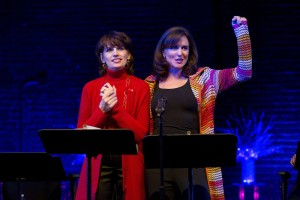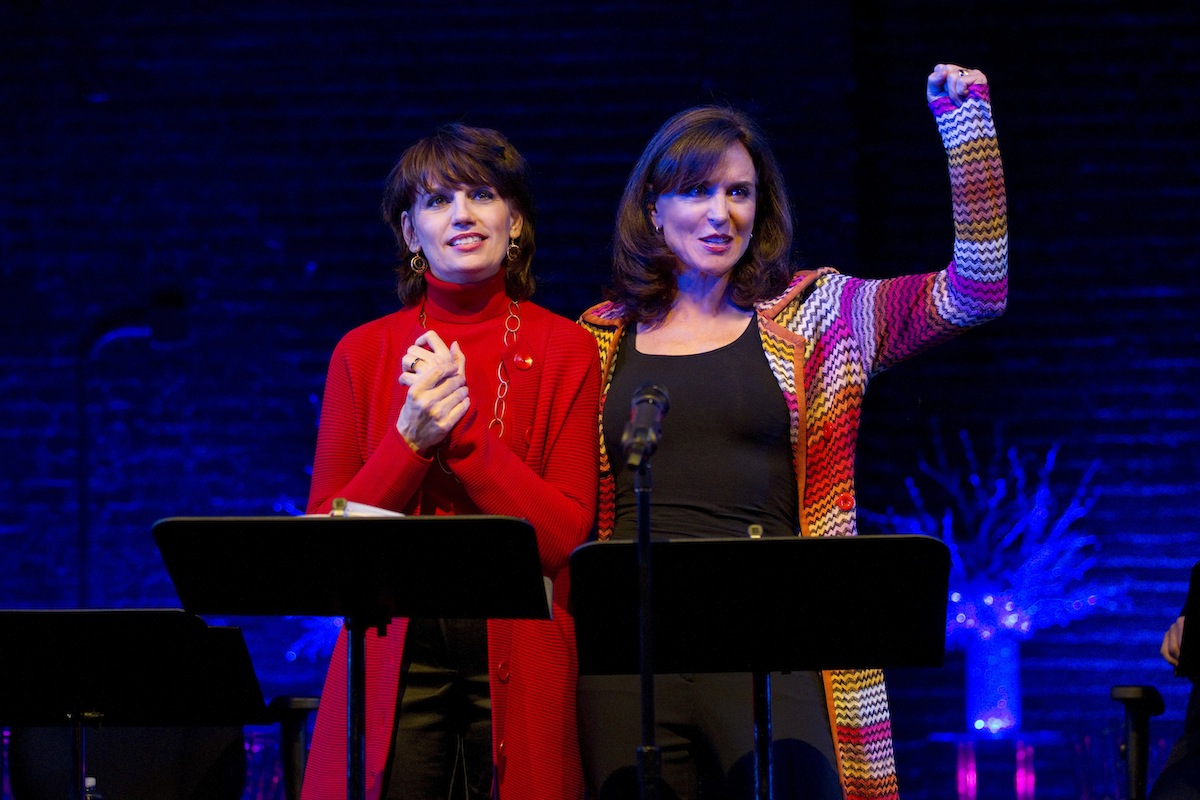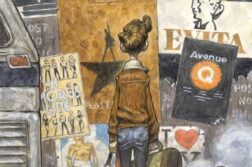Standing on Ceremony: The Gay Marriage Plays
by Mo Gaffney, Jordan Harrison, Moisés Kaufman, Neil LaBute, Wendy MacLeod, Jose Rivera, Paul Rudnick, and Doug Wright
Directed by Stuart Ross
Minetta Lane Theatre, New York
Friends and Relations
by Marc Castle
Directed by Adam Fitzgerald
Havoc Theater, New York
NOTHING CAN SINK a play or movie faster than the fearful prospect that the work in question is either overtly political or polemical. Wasn’t it Sam Goldwyn who quipped to a screenwriter that if you want to send a message, call Western Union? So an evening of one-act plays grouped together to advance the cause of same-sex marriage could potentially put off even its natural supporters. After all, some gay people would rather not be told that gay marriage is the ultimate goal for which we have been fighting lo these last four decades since Stonewall. People of my generation, for example, used to make the case that “marriage” as we’ve known it is a bourgeois, patriarchal institution, imprisoning people in an unreasonable commitment to lifelong monogamy when, by our very nature, humans prefer sexual variety. When I was coming of age, marriage was often characterized as an extension of capitalist structures; its real reason for being was to secure rights of inheritance that descended from customs of tribal kinship. Why, then, would GLBT people ever want to adopt its traditions and restrictions?
Happily, Standing on Ceremony: The Gay Marriage Plays is hardly the dour piece of agitprop that Mr. Goldwyn might have feared. It is, instead, a delightful omnibus of nine one-act plays by a few of our most accomplished playwrights—Neil LaBute, Paul Rudnick, Moisés Kaufman, Mo Gaffney, and Doug Wright—along with several less famous, though no less talented writers. These short pieces of about ten to fifteen minutes each—usually written for two or three characters but in a couple of cases for just one—are performed as a series of staged readings by a spot-on cast of theatre, television, and film veterans, including Richard Thomas (yes, that Richard Thomas: John Boy from The Waltons). Taken together, what these short plays offer is not a party line on same-sex marriage but a sense of the evolving meaning of marriage as part of a broader cultural shift. A social institution once derided by gays because it was both impossible to imagine for ourselves and was denied us with such finality (which is the actual definition of “sour grapes”) is becoming a life option for some, while resistance in the gay community has exposed a distinct fault line in the battle for human rights. As same-sex marriage becomes a reality, those who once derided marriage as an institution are forced to ask themselves whether they want to deny this right to those who think otherwise. The evening’s nine short plays shift registers a few times over some ninety minutes, from lighthearted frivolity to shrewd satire, from lacerating wit to heartfelt sentiment and even, in one brief instant, to grim sorrow. In Jordan Harrison’s “The Revision,” two men (Craig Bierko and Thomas) try to negotiate writing their own wedding vows to avoid traditional phrases in favor of language more accurate to the GLBT situation, so that, for example, “in sickness and in health” becomes “in accordance with the stipulations of our respective health care providers.” In Paul Rudnick’s “The Gay Agenda,” a smug but smiling conservative Christian—the inimitable Harriet Harris—speaking at a conference of like-minded souls, claims to love everyone while proudly declaring her membership in every imaginable “family values” group that demonizes gay people. With a smile as tightly wound as her world-view, her up-with-optimism manner descends into zany paranoia as she itemizes the intrusions of gay people everywhere—especially on TV and movies, where, for example, on Glee and Modern Family there’s “at least one sympathetic and outrageously flamboyant gay character”—just as there is on “every morning show with a weatherman!” Fanning the flames of comparative victimhood, our increasingly unhinged Christian speaker accuses several notable female movie stars, like Sarah Jessica Parker, of always having a “sassy gay best friend” on screen, who, Ms. Harris shouts with loony self-righteous conviction, “are taking jobs away from black women!” “On Facebook,” by Pulitzer Prize winner Doug Wright, offers the sly spectacle of a group of Facebook friends—in this case, the entire cast sitting in a single row across the stage—engaging in a “comment thread.” One of them, a soccer-mom type who claims sympathy with gays, nevertheless betrays her discomfort at redefining the word “marriage.” A gay man takes her sharply to task in his own reply comment. In the ensuing remarks, replete with “thumbs up” and “like” signals from the various “friends,” Wright cleverly demonstrates what passes for political discourse in the digital age. Indeed, “On Facebook” is based on an actual Facebook thread to which Wright was privy. Presumably the names have been changed to protect all concerned. Even within a single one-act play, comic lines dissolve into sweet and sour notes. Polly Draper (of Thirtysomething fame) and Beth Leavel (a Tony winner) play lesbian couples in two of the evening’s pieces. In “This Flight Tonight,” by Wendy MacLeod, they’re preparing to board a plane to Iowa for their wedding. Nerves and cold feet prompt one to envision a future of “monogamy-monogamy-monogamy … until the day we die!” But perhaps the real fear is whether marrying in the state of Iowa is itself a bad omen. In Mo Gaffney’s “Traditional Wedding,” one of the women in a longstanding couple comments on the absurdity of having one’s father giving the bride away. Her own father had given her up at age fifteen when she was caught in a compromising position with another girl. Thrown out of her home, she was “lucky my grandmother took me in.” In their easy give-and-take, Draper and Leavel portray a couple of modern, middle-aged lesbians who are smart, sassy, sexy, and wise. The most trenchant piece—the one that questions a view of same-sex marriage as some magical panacea—is undoubtedly Moisés Kaufman’s “London Mosquitoes,” which takes the form of a eulogy delivered by the widowed lover of a 46-year union. Richard Thomas addresses the audience as if we were joining him at a funeral chapel; he delivers loving anecdotes about his adored Paul, newly deceased. He paints a picture of his life partner as a no-nonsense truth-teller who spared no kind words when the marriage option was finally theirs: “If we married now, we would be having our one-year anniversary next year. What would that say about the last 45 years? That we were just messing around?” Thomas gives an astounding performance, balanced between grief and pride, in his account of love and mourning. The website of Standing on Ceremony announces that the production “will donate a portion of all ticket sales to Freedom to Marry and other organizations promoting marriage equality.” A Los Angeles run has already taken place, and the New York run ended on December 18. Look for local productions—or better yet, get one going. It’s the perfect vehicle for educating the uninitiated. Only a closed heart will be unmoved. MART CROWLEY’S Boys in the Band was the pre-Stonewall model par excellence. In it, the issue of homosexual identity was the dramatic pivot hub for a circle of gay friends at a birthday party. In Terrence McNally’s Love! Valour! Compassion!, this model was elaborated over the course of a summer by the historical accident of AIDS with attendant issues of life and death. Marc Castle’s variation on this theme, Friends and Relations, is a retrospective post-Stonewall version of Boys in the Band passing through the AIDS decade. Once again, we have a circle of gay men—in this case seven—knit together in relations that mimic those of a family. Underlying tensions and unspoken alliances are revealed in spasms of witty, sometimes camp repartee, in short soliloquies addressed to therapists, and in intimate revelations made to sibling-friends—what a straight man might call his “bro’s.” At the center of the piece is Miles, a graphic artist who, though adorable, is unlucky in love at the play’s opening. His eventual up-and-down romance with Corey, a sexy aspiring actor and good-time alcoholic, will explore the ways in which two men negotiate differences in temperament and each other’s expectations. Castle’s play departs from the classic unity of compressed time found in its predecessors. Friends and Relations feels briskly cinematic: the action of the play ping-pongs back-and-forth between encounters among the friends at the end of the 1970’s and others in the mid-to-late 80’s. As we shift from scene to scene, a date is projected on the rear wall of the set, locating us in this ten-year interval of action and in the emotional arc of the characters’ lives. Castle uses these film-like jump-cuts and dissolves by having one scene pick up on a theme from its immediate predecessor. This still requires an audience to be alert to cues of dialogue and able to track relations among seven characters of similar age. Those ages shift between their twenties and thirties in the course of the play, but, alas, the actors do not age during the performance: all portray middle-class white men seeking love and professional status. Gee, even in 1968 Boys in the Band had one Negro! And if their names sometimes bounce around inside one’s head—Corey, Ross, Bobby, Byron—making it difficult to sort out who’s who, at least the actors are well cast as distinct personalities. As in all such plays and movies, where a cross-section represents a generation—think of the army platoons in war movies from the 40’s right up to the more recent Saving Private Ryan—individuals may come treacherously close to stereotype. In this instance, in the character of Ross—the camp, wise-cracking magazine editor who refers to old movies and female movie stars—a stereotype is rescued by the actor Christopher Sloan. He goes at Ross full-throttle. His bitchy queen is like a Greek chorus commenting on the play’s underlying themes through barbed remarks mounted to shield his life as an eternally single gay man. So, when Corey, the actor/waiter, asks early on what the men at the table will have, Ross chimes in, “I’d like a large order of prognosis negative.” He is at once camping à la Bette Davis in Dark Victory (1937) and thematically preparing us for the circle of friends’ coming losses from AIDS. In fact, Act I ends with the same line, this time spoken by Miles, who has just broken up with Corey. AIDS is only remotely mentioned in the first act, but in Act II its presence drives the plot. For all its bubbly banter, the play is deceptively dark, though not always sufficiently deep. It offers an insider’s view of a decade of gay life, and its focus is on a profession in which physical looks are everything: acting in theatre and film. With a substantial career in the theatre, Castle is an expert at staking out this particular territory as thematic grist. The play alludes to other “inside stories” from Broadway and Hollywood lore, such as All About Eve. Three of the main characters are actors, two of them—Corey and Bobby—unsuccessful in their pursuit of careers, but Dean, presumably Miles’s best friend, has managed to make his way to California, where he’s the lead in a TV series playing a handsome man of action. A stage thespian who abandons The Theatre for the easy money and junk culture of Hollywood and TV is a standard trope, but here it gets a fresh twist. Described in Castle’s script as “[a]lmost too good-looking; pleasant, though not always as sharp as his friends,” Dean is a stolid hunk who eventually returns to the Broadway stage, leaving behind a wife and stepchild in L.A. The play touches on, but barely resolves, the psychology of a television sex symbol whose past includes youthful gay camaraderie and who’s now married to a “good woman.” Dean claims that he’s not just trying to secure his heterosexual bona fides, but adds: “She knows I sleep with men. … We’re not like man and wife. We’re really … intimate friends.” This off-stage marital relationship makes Dean something of a mystery in the context of an otherwise unabashedly gay play, yet it underscores a major theme: what makes a gay couple succeed or fail in their love relationship? Besides Miles and Corey, we have Byron and Glen—the former a psychotherapist, the latter a dental student who enters the profession during the play’s time span. If Ross is the play’s cynical queen, Byron is the all-knowing therapist who can diagnose everybody’s weaknesses but his own. He is oddly paired with Glen, a party boy not opposed to finding fresh pleasures behind Byron’s back. Yet theirs is the longest-running relationship in the play, and its demise is never reduced to easy analysis. As Byron himself says to Miles, “There’s a bond between two people that’s incredibly strong after nine years … So I was miserable sometimes. That’s all part of it, Miles.” This echoes Dean’s earlier assertion about his marriage to Janet, another unexplainable union – or should I say unexplained and undramatized. This hints at the play’s fatal flaw: too often skating over emotional issues inside relationships instead of sounding their depths. This is even true of Miles and Dean’s friendship, which is said to be intensely close but is never demonstrated to be that. Castle’s dialogue, however, can certainly hit the mark, and he is adept in creating scenes with pairs and groups of characters whose discussions paint a vivid picture of gay life at a particular time and place: references to Mayor Ed Koch, Anita Bryant, Bella Abzug, and numerous others help set the stage. Miles and Byron are particularly well realized characters, as in this exchange: Miles: Living by yourself is not the real problem. It’s living with yourself. Matt Golden as Miles was especially strong, presenting a man uncertain of his claims to love who grows to accept its limits: “One person can not fulfill all your needs” he says well before the emotional trajectory of the play has run its course. Miles will live through great epiphanies of love with Corey, only to land back to earth and be forced to endure torments of enormous self-doubt. Matt Golden’s performance was fine tuned, natural, and full of pathos. Friends and Relations doesn’t always give its actors the sharpest contours of the characters they must play. Men playing Corey, Glen, and Bobby will have to invent more than is on the page—as the New York company did. And we could have wished that Marc Castle had given each relationship its fullest due, so that the play’s rapier wit had been matched by something cutting in deeper measure. But Friends and Relations is surely more than a modest success, dealing as it does with a decade that began with so much promise and ended with gay people sadder, but wiser, or so we hope. Allen Ellenzweig is the author of The Homoerotic Photograph
Byron: I know that, Miles. I’m a therapist.
Miles: You know it but you don’t deal with it. Let’s face it. Therapists are the most fucked up people I know.
Byron: You’re not just saying that to make me feel better? (1992) and a frequent contributor to this journal.





